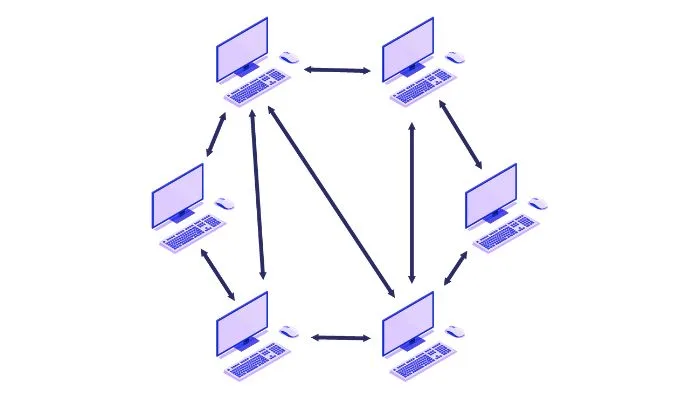Table of Contents
What is P2P?
P2P, or Peer-to-Peer, is a network architecture that allows computers to communicate and share resources directly with each other, without the need for a central server. In a P2P network, each computer, or peer, acts as both a client and a server, enabling it to both request and provide resources.
At its core, P2P refers to a network in which every participant (node) has equal status and is capable of both sharing and accessing resources without the need for a central server. This decentralization is the defining characteristic of P2P networks and is in contrast to the client-server model, where a central server controls and mediates data exchanges.
Key Elements of P2P Networks
- Nodes and Peers: In a P2P network, every device or computer is considered a node, and each of these nodes is referred to as a peer. The term “peer” emphasizes the equal status of all participants in the network.
- Direct Communication: Peers in a P2P network can communicate directly with each other without relying on intermediaries. This direct interaction enables efficient data sharing and real-time communication.
- Resource Sharing: P2P networks are designed to facilitate the sharing of resources among peers. These resources can include files, processing power, or even internet bandwidth.
- Dynamic Participation: Users can join or leave a P2P network at will. This flexibility is one of the strengths of P2P networks, making them highly adaptable.
P2P Network Architecture
A P2P network typically consists of a group of interconnected peers, forming a decentralized network. Unlike traditional client-server networks, where a central server handles all the requests and resources, P2P networks distribute the workload among the peers. This architecture ensures that the network remains robust and resilient, as there is no single point of failure.
In P2P networks, each device connected to the network is referred to as a “node.” Importantly, every node is considered a “peer,” emphasizing the equal status and capabilities shared by all participants. In other words, in a P2P network, there is no central authority or hierarchy.
The hallmark of P2P network architecture is its decentralization. Unlike traditional client-server networks where a central server manages connections and data distribution, P2P networks lack a central point of control. Instead, peers communicate directly with each other.
Peers in a P2P network can communicate with each other directly. This direct interaction enables efficient data sharing, real-time communication, and resource sharing without the need for intermediaries. It also reduces latency, making P2P networks suitable for various applications.
How do P2P Networks Work?
When a peer in a P2P network wants to access a resource, it sends a request to other peers in the network. The request is propagated through the network until it reaches a peer that has the requested resource. This peer then directly shares the resource with the requesting peer. This process is known as file sharing and is the fundamental function of P2P networks.

Peer-to-peer (P2P) networks are a revolutionary way of sharing and distributing data, fundamentally different from traditional centralized networks. In this explanation, we will delve into how P2P networks work, emphasizing their unique mechanisms for efficient data exchange and communication.
P2P networks are characterized by their decentralized nature, where every participant, or peer, holds equal status and can act as both a consumer and a provider of resources. Here’s how P2P networks operate:
1. File Sharing Mechanism
P2P networks are renowned for their efficient file-sharing mechanisms. When a user wants to download a file from a P2P network, they don’t connect to a central server. Instead, they connect directly to other peers who possess the desired file. Here’s how the process works:
- File Division: The file to be shared is divided into smaller, manageable pieces or chunks. This fragmentation is a key part of the P2P architecture.
- Simultaneous Download: When a user initiates a download, they connect to multiple peers that have the same file. Each peer contributes by providing different chunks of the file. These chunks are downloaded simultaneously from multiple sources.
- Piece Reassembly: As these chunks are received, they are reassembled on the user’s device to reconstruct the original file. This parallel downloading from multiple sources enhances download speeds and overall reliability.
2. Data Distribution
In P2P networks, data is typically fragmented into small parts or blocks, and each peer shares these pieces with others. This fragmentation has several advantages:
- Redundancy: Since multiple peers hold fragments of the same data, there is built-in redundancy. If one peer goes offline or experiences an issue, the network can retrieve the missing data from other available sources.
- Efficiency: By sharing smaller pieces of data, P2P networks reduce the burden on individual peers and optimize network bandwidth usage. This contributes to faster and more reliable data exchange.
- Resilience: P2P networks are known for their resilience. If a peer leaves the network, the data remains available through other peers, ensuring continuous access.
Ensuring Data Integrity
P2P networks also incorporate mechanisms to ensure data integrity, such as checksums or hashes, which are used to verify the integrity of downloaded chunks. If a chunk is found to be corrupted or incomplete, the P2P client can request that specific piece from another peer. This process continues until all required data is obtained and verified.
Types of P2P Networks
There are two main types of P2P networks: structured and unstructured. Structured P2P networks use distributed hash tables (DHTs) to organize and locate resources efficiently. Examples of structured P2P networks include BitTorrent and Napster. Unstructured P2P networks, on the other hand, do not have a predefined structure and rely on flooding or random search algorithms to locate resources. Examples of unstructured P2P networks include Gnutella and Kazaa.
1. Unstructured P2P Networks
Unstructured P2P networks are characterized by their lack of a defined hierarchy or organization among peers. These networks are highly flexible and dynamic, making them suitable for applications where adaptability is essential.
Key Features of Unstructured P2P Networks:
- No Centralized Control: Unstructured P2P networks lack a central authority or server that manages connections and data distribution. Instead, peers connect directly to each other.
- Dynamic Membership: Peers can join or leave the network at will without significantly impacting network functionality. This adaptability is advantageous for applications with varying participation.
- Efficient for File Sharing: Unstructured P2P networks are well-suited for applications like file sharing where users might join and leave the network frequently.
- Example: Gnutella: Gnutella is a classic example of an unstructured P2P network used for file sharing. Users can search for and download files directly from other peers.
2. Structured P2P Networks
Structured P2P networks employ a specific organizational structure for data distribution and peer arrangement. This structured approach enhances the efficiency of data retrieval and searching, making them ideal for applications requiring precision.
Key Features of Structured P2P Networks:
- Organized Network: Structured P2P networks have a specific organization where data is distributed following a predefined structure. This structure aids in efficient data retrieval.
- Consistent Searching: Structured networks offer consistent and predictable search results. Users can quickly locate data by following the defined structure.
- Efficient Indexing: Data in structured networks is indexed systematically, simplifying search and retrieval processes.
- Example: Distributed Hash Tables (DHTs): DHTs, such as Chord and Kademlia, are examples of structured P2P networks used for efficient key-value data storage and retrieval. They use a structured system of distributed hash tables to locate data quickly.
3. Hybrid P2P Networks
Hybrid P2P networks combine elements of both unstructured and structured networks, offering a balance between the flexibility of unstructured networks and the efficiency of structured networks. These networks aim to harness the strengths of both approaches.
Key Features of Hybrid P2P Networks:
- Flexibility and Efficiency: Hybrid networks aim to provide the flexibility of unstructured networks for dynamic participation while incorporating the efficiency of structured networks for data retrieval.
- Defined Structure for Some Data: In hybrid networks, part of the data may follow a structured arrangement for efficient access, while other data might be shared in an unstructured manner, allowing for adaptability.
- Optimal for Various Applications: Hybrid networks can cater to a wide range of applications by offering a balance between precision and adaptability.
- Example: Overnet: Overnet is an example of a hybrid P2P network that combines structured elements for efficient indexing and unstructured elements for flexibility in sharing.
These types of P2P networks demonstrate the adaptability of P2P technology to various use cases and requirements. Unstructured networks are ideal for applications where dynamic membership is essential, structured networks excel in efficient data retrieval, and hybrid networks offer a balance between the two, providing flexibility and precision where needed. The choice of P2P network type depends on the specific needs of the application or service being developed.
Applications of P2P Networks
P2P networks have numerous applications in various fields. One of the most well-known applications is file sharing, where users can share and download files directly from other peers. P2P networks are also used in content distribution, where large files, such as software updates or multimedia files, are distributed among peers to reduce bandwidth usage on centralized servers. Additionally, P2P networks are utilized in communication applications, such as voice-over-IP (VoIP) and instant messaging.
P2P networks have found applications in a multitude of fields:
- File Sharing: P2P is renowned for its role in file sharing, with platforms like BitTorrent and eMule.
- Video Conferencing: Applications like Skype and Zoom use P2P architecture for real-time communication.
- Content Delivery: CDNs use P2P for efficient content delivery.
- Distributed Computing: Projects like SETI@home use idle computer resources for scientific research.
- Online Gaming: P2P networks facilitate multiplayer gaming with minimal latency.
Advantages and Disadvantages of P2P
Advantages
- Decentralization: P2P networks are resistant to single points of failure.
- Efficiency: They distribute workloads efficiently, ensuring fast downloads.
- Scalability: P2P networks can easily scale with the addition of new peers.
- Cost-Effective: No need for expensive central servers.
- Privacy: Direct communication between peers offers enhanced privacy.
Disadvantages
- Security Concerns: P2P networks can be vulnerable to security breaches.
- Quality Control: Content quality in P2P networks can vary widely.
- Legality Issues: Many P2P networks are associated with copyright infringement.
- Network Congestion: Popular files can lead to network congestion.
- Complexity: Setting up P2P networks can be complex for beginners.


